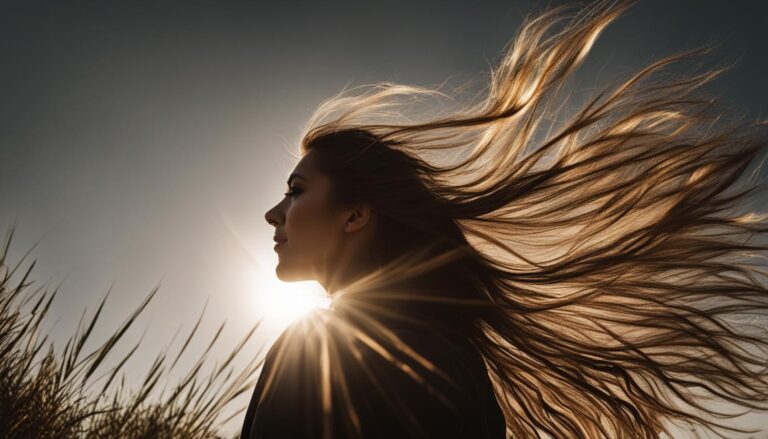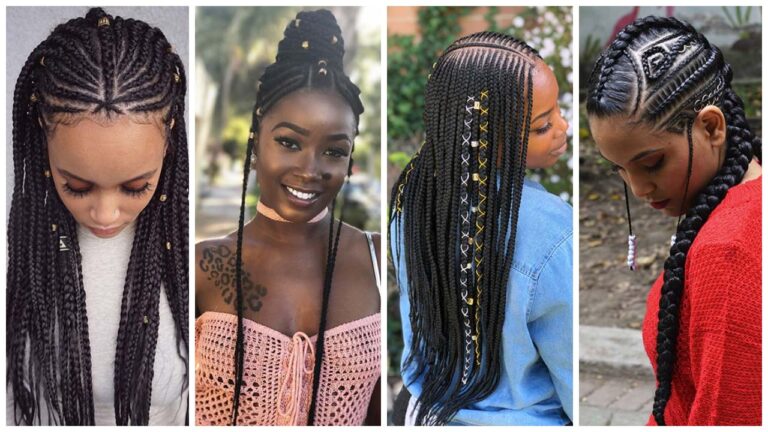Why is Afro Hair Curly?
Afro hair, also known as Afro-textured hair, is characterized by its distinctive curls and coils. But what causes this unique texture? In this article, I will explore the genetics, structure, and formation of Afro hair to understand why it is naturally curly.
The genetics behind Afro hair texture are still being studied, but we do know that the shape of the hair follicles plays a significant role. While round follicles produce straight hair, oval-shaped follicles give rise to curly hair. Afro-textured hair has ribbon-like follicles, contributing to its tight coils and curls.
Another factor contributing to the curly nature of Afro hair is the oils produced by the scalp. African hair tends to produce more oils than other hair types, but the tight curls prevent the even distribution of these oils along the hair strands. This can lead to dryness and brittleness, making the hair more prone to breakage and resulting in shorter hair length.
While the exact genes responsible for the texture of African hair have not yet been identified, it is believed to be a genetic trait passed down through generations. The unique structure and genetic factors combine to create the beautiful, curly texture of Afro hair.
Key Takeaways:
- Afro hair is curly due to the shape of the hair follicles.
- Oval-shaped follicles result in tight coils and curls.
- African hair produces more oils, but the tight curls prevent even distribution, leading to dryness and brittleness.
- The genetics behind Afro hair texture are still being studied.
- The unique structure and genetic factors contribute to the curly nature of Afro hair.
The Science behind Afro Hair Texture
The texture of Afro hair is determined by the size and shape of the hair follicles. Round follicles produce straight hair, while oval-shaped follicles give rise to curly hair. The size of the follicles determines the thickness of the individual hair strands. Large follicles produce thick hairs, while small follicles produce thin hairs. The density of the hair, or the number of hairs on the scalp, is determined by the number of follicles.
Afro hair is often coiled and has a unique texture due to the nearly flat, ribbon-like structure of its follicles. The tightly coiled and densely packed follicles contribute to the tight curls and coils of Afro-textured hair. This unique structure also affects the hair’s ability to retain moisture. Afro hair produces more protective oils called sebum, but the tight curls prevent the even distribution of these oils along the hair strands, resulting in dryness and brittleness.
The brittleness of Afro hair makes it more prone to breakage. The stresses caused by the tight curls can lead to hair breakage, resulting in shorter hair length. Although the exact genes responsible for the texture of Afro hair have not yet been identified, it is believed to be a genetic trait passed down through generations. Genetic factors play a significant role in determining the texture, thickness, and density of Afro hair.
Curly Hair Formation and Growth Factors
The formation of curly hair is a complex process that begins at the cellular level. It involves the clustering of protein cells in the derma papilla, which then form bonds asymmetrically. These bonds, along with the other cells in the inner sheath, create rigid protein structures that give rise to an oval-shaped hair follicle. This unique follicle shape contributes to the curl and kink of the hair as it grows.
Curl patterns are further influenced by a specific amino acid called cysteine. Afro-textured hair types typically have a higher concentration of cysteine, resulting in dense curls. The fine circumference of these hair follicles gives the illusion of thickness, but the tight curl patterns also make the hair more vulnerable to breakage.
To maintain healthy curly hair, proper hair care is essential. This includes regular shampooing and conditioning to keep the hair moisturized and nourished. Using a leave-in conditioner can help reduce breakage and protect the hair from external stressors. By implementing these hair care practices, individuals with curly hair can promote healthy growth and minimize damage.
Comparing Afro Hair with Other Hair Types
Afro hair stands out from other hair types due to its unique structure, density, and growth rate. Understanding these differences is essential for those looking to care for and style Afro-textured hair effectively. Here are some key comparisons between Afro hair and other hair types:
1. Hair Structure
Afro hair has a distinct structure characterized by flattened cross-sections and tight curls. The flattened shape contributes to the formation of smaller ringlets compared to other hair types. Additionally, the lower density of Afro hair gives it an airy appearance, with fewer hairs per square centimeter.
2. Hair Density and Growth Rate
Afro hair is often less dense compared to other hair types. This means that there are fewer hairs on the scalp, creating a relatively sparse appearance. Additionally, Afro hair tends to have a slower growth rate compared to straight European-textured hair.
3. Shrinkage
A unique characteristic of Afro hair is its high degree of shrinkage. When in its natural, coily state, Afro hair appears shorter compared to its actual length. This shrinkage is due to the tight curl pattern and can make it challenging to gauge the true length of Afro-textured hair.
4. Genetic Differences
The differences in hair structure, density, and growth rate are largely influenced by genetic factors. Genetic variations contribute to the unique characteristics of Afro-textured hair, setting it apart from other hair types.
The Evolutionary Significance of Afro Hair
Afro-textured hair, with its tight coils and curls, has evolved as a remarkable adaptation to hot climates, particularly in Africa. This unique hair texture serves multiple purposes, providing protection against intense UV radiation, facilitating body temperature regulation, and meeting specific moisture requirements.
The Protection Against UV Radiation
The kinky texture of Afro hair acts as a natural shield against harmful UV radiation. The tight coils and curls create an airy effect, allowing increased circulation of cool air onto the scalp. This helps to regulate body temperature and prevent overheating in hot climates.
Body Temperature Regulation
Afro hair’s elastic helix shape and relatively sparse density contribute to effective body temperature regulation. The interwoven curls allow for increased airflow, aiding in the evaporation of sweat and promoting cooling. This evolutionary adaptation helps individuals with Afro-textured hair feel more comfortable in tropical climate conditions.
Moisture Requirements
One of the distinctive characteristics of Afro-textured hair is its higher moisture requirements compared to other hair types. The tight curls make it more difficult for natural oils produced by the scalp, known as sebum, to distribute evenly along the hair strands. As a result, Afro hair tends to be drier and requires regular moisturization to maintain its health and vitality.

The cultural significance of Afro-textured hair cannot be overlooked. Throughout history, Afro hair has held great pride and importance in various communities, serving as a symbol of identity, beauty, and heritage. It continues to be celebrated today as a testament to natural beauty and individuality.
The Historical and Cultural Significance of Afro Hair
In many cultures, hair grooming practices have held significant social and cultural importance. Among Sub-Saharan African communities and the African diaspora, hair styling has served as a form of artistic expression, a way to strengthen community bonds, and a means to convey identity, age, social rank, and cultural traditions. Hair braiding, in particular, has been a cherished practice, passed down through generations, and has become an art form in its own right.
Throughout history, African hairstyles have adapted and evolved, shaped by the experiences and circumstances of the people who wore them. During the Trans-Atlantic slave trade, enslaved Africans faced the challenge of maintaining their hair health under harsh conditions. They utilized various techniques, such as using sheep-fleece carding tools to detangle their hair and protective styling to minimize damage.
“Hair is a symbol of beauty, pride, and cultural heritage in many African communities. It is a way for us to embrace and celebrate our natural selves.”
The political significance of Afro-textured hair emerged during the Black Power Movement in the United States, where natural, kinky hair became a symbol of Black pride and the rejection of societal norms. This movement highlighted the importance of embracing one’s natural hair texture and challenging Eurocentric beauty standards that often marginalized Afro-textured hair.
Hair Care Traditions and Challenges
Hair care traditions have been passed down through generations, with careful attention given to the specific needs of Afro-textured hair. These traditions often involve the use of natural oils, butters, and moisturizers to maintain moisture and prevent dryness. However, scalp diseases, such as dandruff and psoriasis, can pose challenges to hair care and require special care and treatment.
The Intersection of Hair Politics and Identity
Hair politics has played a significant role in shaping cultural identity, particularly for people of African descent. The way hair is styled and worn has been subject to discrimination, stereotypes, and societal expectations. Embracing Afro-textured hair and celebrating its beauty has become a powerful statement of self-acceptance and pride.
“Black hair is not just about aesthetics; it is a symbol of resilience, resistance, and cultural heritage.”
Black pride movements have worked to challenge beauty standards and promote inclusivity and acceptance of all hair textures. By embracing and celebrating Afro-textured hair, individuals are reclaiming their identity, challenging societal norms, and promoting diversity and representation.
Beauty Standards and Beyond
The historical and cultural significance of Afro hair goes beyond beauty standards. It represents a rich and diverse heritage, a celebration of cultural traditions, and a way to express personal and collective identities. From traditional hair braiding techniques to modern hair care practices, Afro-textured hair continues to be cherished and celebrated, serving as a symbol of beauty, pride, and resilience.
Conclusion
The unique texture of Afro hair, characterized by its tight coils and curls, is determined by the shape of the hair follicles and genetic factors. The structure and density of Afro-textured hair differ from other hair types, making it more prone to dryness, brittleness, and breakage.
Proper hair care and maintenance are essential for healthy Afro hair growth. Regular shampooing, conditioning, and the use of leave-in conditioner can help reduce breakage and promote overall hair health. By keeping the hair moisturized and providing necessary nutrients, these practices support the growth and strength of Afro-textured hair.
Afro-textured hair has evolved as an adaptive trait, particularly in response to hot climates. Its tight coils and curls provide natural protection against UV radiation, reducing the risk of sun damage to the scalp. Additionally, the structure of Afro hair allows for enhanced body temperature regulation, making it more comfortable in warm environments.
Throughout history, Afro-textured hair has held significant cultural and political significance. It is a source of pride, identity, and a celebration of natural beauty. From ancient traditions to modern expressions, Afro-textured hair represents a rich tapestry of cultural heritage and individuality.
FAQ
Why is Afro hair curly?
Afro hair is curly due to the shape of the hair follicles. Oval-shaped follicles produce curly hair, while round follicles result in straight hair.
What makes Afro-textured hair unique?
The unique structure of Afro-textured hair, with ribbon-like follicles, contributes to its tight coils and curls.
Why is Afro hair prone to dryness and brittleness?
African hair produces more oils, but the tight curls prevent the even distribution of these oils along the hair strands, leading to dryness and brittleness.
Why does Afro hair tend to be shorter?
The stresses caused by the tight curls make Afro hair prone to breakage, resulting in shorter hair length.
Is the texture of Afro hair determined by genetics?
While the exact genes responsible for the texture of African hair have not yet been identified, it is believed to be a genetic trait passed down through generations.







